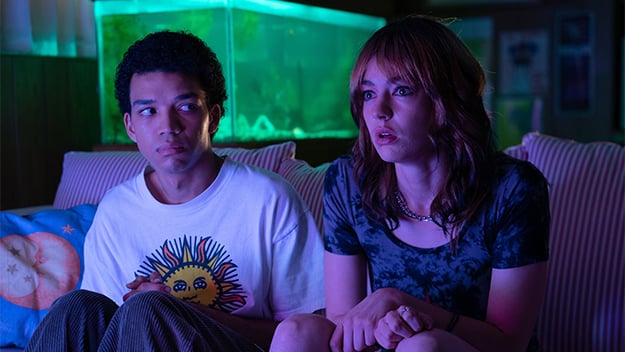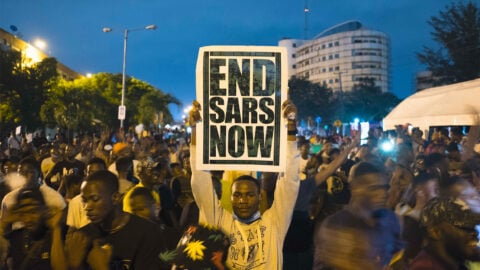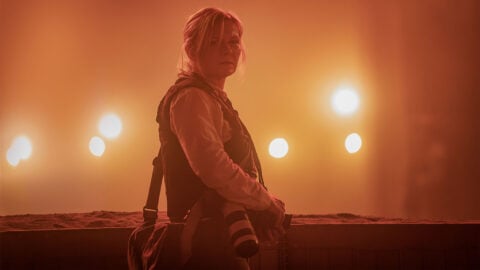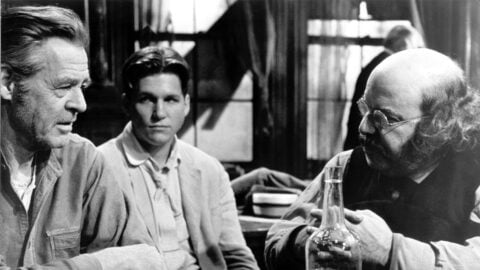Interview: Jane Schoenbrun on I Saw the TV Glow
This article appeared in the January 26, 2024 edition of The Film Comment Letter, our free weekly newsletter featuring original film criticism and writing. Sign up for the Letter here. Catch up on all of our Sundance 2024 coverage here.

I Saw the TV Glow (Jane Schoenbrun, 2024). Courtesy of A24 Films.
The history of cinema abounds with “trans film images”—images that, directly or indirectly, purposely or incidentally, capture the life experience of trans people—even as trans creators have remained notably absent behind and in front of the camera. But recent years have seen the emergence of a full-throated trans film movement, of which Jane Schoenbrun is one of the most vital voices. Along with directors like Vera Drew, Alice Maio Mackay, and Isabel Sandoval, Schoenbrun is producing a body of work—including 2021’s We’re All Going to the World’s Fair and the new I Saw the TV Glow, which premiered last week at the Sundance Film Festival—that foregoes the traditional tropes associated with transness on screen, such as medical transitioning, opting instead to reinterpret genres like classic melodrama, comic-book adventure, and body horror through the lived experience of transness. In I Saw the TV Glow, Schoenbrun manipulates the conventions of horror aimed at an audience of teenagers and young adults to give disassociation and gender dysphoria an honest cinematic embodiment—with visual grammar rather than direct representation.
I Saw the TV Glow follows its protagonist, Owen, on his journey from his preteen years in the mid-’90s (where he’s played by Ian Foreman) into young adulthood in the 21st century (with Justice Smith taking over the role). Owen and his friend Maddy (Brigette Lundy-Payne) share an obsession with a TV series called The Pink Opaque, which takes its cues from horror-tinged television programs of the ’90s aimed at adolescents, like Are You Afraid of the Dark? and Buffy the Vampire Slayer. The show-within-the-movie follows heroes Isabel (Helena Howard) and Tara (Lindsey Jordan) as they try to defeat the “big bad” Mr. Melancholy—a villain who lives on the moon, and whose visage resembles Georges Méliès’s iconic image from A Trip to the Moon (1902). Things become strange when reality and fiction begin to blend together and Maddy and Owen are no longer sure if the characters they are watching on TV are fictional, or versions of themselves.
I spoke with Schoenbrun via video call shortly after the film’s premiere. We discussed how they developed a transgender visual language, the limits of direct representation, and the complexity of nostalgia for trans people.
Transness is difficult to communicate visually in film, because, unlike queer sexuality, it doesn’t have a definitive image. I’d like to know how you conceive of the trans film image when directing.
I know what I want to avoid in conceiving and representing images of transition or dysphoria, or the feelings associated with transness. What I want to avoid are external, physical manifestations of transness. In this film, I did cave in. There are some shots of, for example, the trans character putting on a dress for the first time. But, generally speaking, I feel like I’m not being true to my own experience when I lean on the external signifiers of womanhood versus manhood. When I am unpacking something that’s deeply personal to my experiences, an internal liminality or “wrongness”—that feels right.
In this film, we see that explicitly through the image of television static—the titular “TV glow.” This flickering, ambient wrongness— which is also sort of beautiful—is a metaphor that I feel represents my own experience of coming into myself and my form. One small moment that I would point out is the close-up of Owen with a big bushel of cotton candy during a carnival. You see him spit into the cotton candy, and the cotton candy dissolving. It’s a surreal image of something being sizzled through. To me, that’s a trans image. It’s related to this internal fuzziness that’s at play throughout the film.
There’s a nostalgic quality to I Saw the TV Glow. But nostalgia is also a trap for trans people, especially those who grew up in the ’90s, as Owen does, because representative images were either invisible or compromised on screen. Does that mindset apply to Owen, who is looking for something he doesn’t necessarily have the words for?
When I think back to the invisible or subtle flickers of beauty that I caught in the media while growing up, and which I clung to in the way that Owen clings to things in the film, it was never as direct as: “Oh, look! There’s transness.” Whether it was a fixation with goth iconography, or a style of music, it was clearly me trying to express an identity that could commune with something more gentle, that could never be thought of as masculine. The media that made an impact on me as a kid who wasn’t ready to accept my gender identity was stuff that I felt like I could cosplay through, much in the way that Owen and Maddy are cosplaying through the characters of The Pink Opaque. For me, it was never about finding representations of transness as much as about finding my personal relationship with beauty and things that I felt were beautiful, and communing with them.
The acting in this film is extraordinary. Justice Smith, Ian Foreman, and Helena Howard are all contributing to a full portrait of who Owen is. Do you think showing these potential versions of a person is important in capturing transness as a type of hauntology?
I don’t necessarily think that in a portrait of transness we need to see the person that they were before the egg cracked [“egg” is a slang term used by trans people to express who they were before they came out], or the person that they were after the egg cracked, or the person that they want to be. I don’t think we need an entire lifetime’s worth of growth to understand somebody. I would love to make films where we’re seeing just snapshots of who somebody is in very specific moments. But the images and auras of the characters have to be interconnected. They all have to add up to something emotional. That is obviously true in this film with Ian’s, Justice’s, and Helena’s performances. Helena is standing in, as not so much a side of Owen but as the idealized image of who he maybe longs to be without even realizing it.
Your last two films are precise about how important it is to find oneself through images, but also about how limiting that can be.
In childhood, we look for hints of who we are in the world around us. But as you grow up and respond to all of the coded ways in which the world tells you who you have to be, and certainly as a trans person who hasn’t yet accepted that they need to transition, those same images can become a coping mechanism. At a certain point, Owen isn’t so much living in those shows as he is returning to them because it’s a safe way to ingest or mainline an identity. In my own experience, that process, like any kind of addictive process, is going to eventually leave you a little bit empty. You chase something that feels increasingly further away. The relationships between characters and screens in the film is quite complex, but the arc goes from something that is offering a hint of liberation to one that’s maybe more of a prison.
One of my favorite things about this film, and your work in general, is how the camera communicates a feeling of disassociation or gender dysphoria. What was your collaboration like with cinematographer Eric Yue? Were there any works of art that inspired the visual language of I Saw the TV Glow?
Much of the process of working with Eric on the visuals was about building this candy-colored, nostalgic, ’90s TV aesthetic. Eric and I have been talking a ton about Joel Schumacher’s Batman movies [Batman Forever (1995) and Batman & Robin (1997)], which are obviously not movies that we were looking to as an emotional reference for Owen, but which had a heightened, hyperreal world which we haven’t seen on the screen since then. Another big one for us was Kieślowski’s Blue (1993), specifically in the way that the shots are obscured by glassware or glass marbles to create these refracted images that are incredibly lush and colorful, but also messy.
Trans cinema is such a nebulous idea because it’s historically been compromised by cisgender artists telling these stories, or by the lack of employment opportunities for trans folks within the industry. But we’re beginning to see a change with films like yours and Vera Drew’s The People’s Joker (2022), where there is a remixing of other films in a manner that feels very specific to transness. I’d love to hear your thoughts on how it feels to be in the vanguard of trans directors who take familiar images and make them their own—or “transition” them.
This has been a guiding force in my work since long before I even realized I was trans. I call it mutation—this desire to mutate the images and iconography that I have been fed all my life, and, as you said, transition them into a form that is almost like the “glow” in my film: equal parts beautiful and grotesque. There is a lot to be said about how that desire relates to a trans gaze, especially the dissociative “egg” gaze of growing up in a haze where you’re looking to images to show you something that feels like real life. And those images give you both beauty and romance, but in a way that is kind of sinister.
I wrote a really long article about this idea. I had just quit my job, and was obsessed for a minute with this YouTube rabbit hole that I named “fan mutation.” These were online videos that remade episodes of The Simpsons, or Dilbert, or Shrek, into these grotesque forms without any kind of license—not even in a way that could be classically construed as parody. I would definitely group Vera’s film with that trend. I think what is underpinning these videos, which I relate to in my own work, is a desire to troll hegemonic forms that are controlled by these corporate powers. Beyond that, it’s also a nightmare-fueled desire to take someone else’s idea of beauty and reveal what’s rotten and unreal underneath.
There are so many terrifying legislative decisions coming out of the United States and elsewhere right now, trying to restrict trans people from access to human rights, including a bathroom ban that passed in the Utah House while you were at Sundance. Did this pattern of anti-trans legislation influence the tone of this film and what you wanted to say?
As a trans artist in the world, there’s no way not to be making work about how it feels to be trans, and to be perceived by the majority of people as illegitimate at best and as a threat that needs to be exterminated at worst. It’s totally fucking insane to be on a stage at Sundance being celebrated for my art, while at the same time, I’m in danger. As I’ve grown more and more into someone who could be construed as a public figure, how could my work not be influenced by that? The insanity of being trans in the public eye?
The villain in I Saw the TV Glow ultimately is the gaze on these characters. That’s why Mr. Melancholy stares down at them from the sky, keeping them obedient, letting them know that they are looked at, and that that look is going to control who they can be. I try to make work that is aware of this control and comes from an anti-fascist perspective that believes that kind of power can be attacked. On a political level, I am as terrified as any other trans person by the specter of trans death and the risks associated with being trans. What is the role of the artist? And what is the role of the trans artist in a disgusting culture? I’m doing my best to speak honestly, and part of that is speaking politically and understanding that everything I do and say is political.
Willow Catelyn Maclay is a freelance film critic and co-author of the upcoming book Corpses, Fools and Monsters: An Examination of Trans Film Images in Cinema. She has written for numerous outlets including The Village Voice, MUBI, and Reverse Shot.







